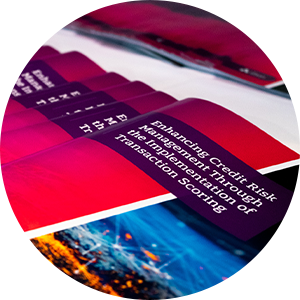illion understands the evolving credit industry, and has created a first in class transaction score which offers credit providers a powerful tool to enhance their credit decisioning process.
Many sophisticated analytics teams are starting to assess the ability of transaction and spend behaviour to support risk scoring as they prepare for the launch of open banking. illion has been providing transaction data and assessing patterns, trends and predictability over the past 7 years.
Utilising our expertise in bank statement data and credit scoring, we have built a market first – the illion Transaction Risk Score (iTRS).
The illion Transaction Risk Score (iTRS) allows illion’s customers to improve their credit management with more informed underwriting and pricing. Leveraging illion’s BankStatements capability, iTRS provides powerful new insights into applicants’ financial behaviour.
How we created the score
illion built and analysed over 1,000 business-interpretable bank transaction features, then used a combination of traditional modelling and machine learning techniques to develop iTRS.
These features were crafted using illion’s access to over one billion transactions from over 2.5 million accounts and 160 financial institutions.
illion Transaction Risk Score
There are two versions of the score: a ‘Traditional’ score (iTRS) and a ‘Machine Learning’ score (iTRS-ML). Both scores range from 0 to 1,000, as the illion Consumer Risk Score does.
iTRS
Logistic Regression. Hand-crafted for business interpretability
iTRS combines data features using a traditional modelling technique, Logistic Regression. This linear modelling technique has been an industry standard for decades, supporting iTRS to ensure it remains robust over time.
Every data feature that is used in the score calculation has been validated by credit experts to ensure that the feature’s contribution to a score follows a logical trend.
iTRS-ML
Extreme Gradient Boosting (XGB). Able to quickly re-build and deploy.
iTRS-ML combines data features using a Machine Learning technique called Extreme Gradient Boosting, or XGBoost for short. This approach can better identify non-linear trends in applicants’ transaction patterns.
While iTRS-ML has been shown to deliver superior business outcomes over iTRS for some credit providers, this benefit comes at the cost of reduced model interpretability.
iTRS-ML will be updated periodically into the future to further improve its power.
Example: Transaction data patterns that are indicative of applicant risk
- Applicants with BNPL fees show 70% higher bad rates than those without BNPL fees
- Applicants who sign up for direct debits are 20% lower risk than those who don’t
- Presence of Debt Collection activity means 2.2x higher credit risk
Delivering benefits to credit providers
Case studies found that the illion Consumer Risk Score (iCRS) used in combination with the illion Transaction Risk Score, is highly effective when it comes to accepting more applicants and reducing bad debt. iTRS can be implemented into a simple refer or decline rule or integrated with an application score.
From one case study it was found that if the credit provider used iTRS in addition to iCRS, the lender could achieve a profit increase of 20%. This incremental benefit is especially important to realise in periods of tighter lending and riskier credit.



